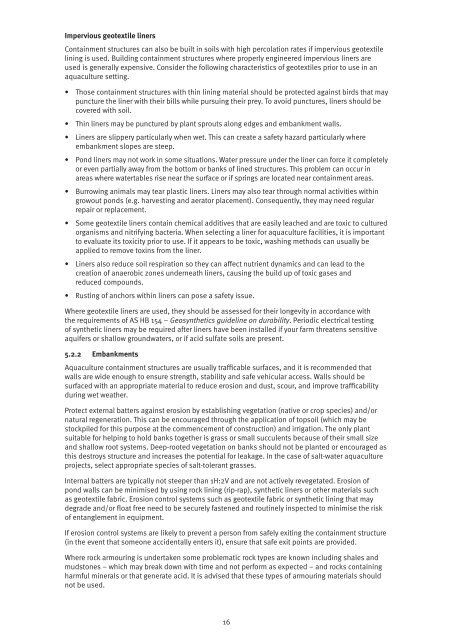Guidelines for constructing and maintaining aquaculture ...
Guidelines for constructing and maintaining aquaculture ...
Guidelines for constructing and maintaining aquaculture ...
You also want an ePaper? Increase the reach of your titles
YUMPU automatically turns print PDFs into web optimized ePapers that Google loves.
Impervious geotextile liners<br />
Containment structures can also be built in soils with high percolation rates if impervious geotextile<br />
lining is used. Building containment structures where properly engineered impervious liners are<br />
used is generally expensive. Consider the following characteristics of geotextiles prior to use in an<br />
<strong>aquaculture</strong> setting.<br />
• Those containment structures with thin lining material should be protected against birds that may<br />
puncture the liner with their bills while pursuing their prey. To avoid punctures, liners should be<br />
covered with soil.<br />
• Thin liners may be punctured by plant sprouts along edges <strong>and</strong> embankment walls.<br />
• Liners are slippery particularly when wet. This can create a safety hazard particularly where<br />
embankment slopes are steep.<br />
• Pond liners may not work in some situations. Water pressure under the liner can <strong>for</strong>ce it completely<br />
or even partially away from the bottom or banks of lined structures. This problem can occur in<br />
areas where watertables rise near the surface or if springs are located near containment areas.<br />
• Burrowing animals may tear plastic liners. Liners may also tear through normal activities within<br />
growout ponds (e.g. harvesting <strong>and</strong> aerator placement). Consequently, they may need regular<br />
repair or replacement.<br />
• Some geotextile liners contain chemical additives that are easily leached <strong>and</strong> are toxic to cultured<br />
organisms <strong>and</strong> nitrifying bacteria. When selecting a liner <strong>for</strong> <strong>aquaculture</strong> facilities, it is important<br />
to evaluate its toxicity prior to use. If it appears to be toxic, washing methods can usually be<br />
applied to remove toxins from the liner.<br />
• Liners also reduce soil respiration so they can affect nutrient dynamics <strong>and</strong> can lead to the<br />
creation of anaerobic zones underneath liners, causing the build up of toxic gases <strong>and</strong><br />
reduced compounds.<br />
• Rusting of anchors within liners can pose a safety issue.<br />
Where geotextile liners are used, they should be assessed <strong>for</strong> their longevity in accordance with<br />
the requirements of AS HB 154 – Geosynthetics guideline on durability. Periodic electrical testing<br />
of synthetic liners may be required after liners have been installed if your farm threatens sensitive<br />
aquifers or shallow groundwaters, or if acid sulfate soils are present.<br />
5.2.2 Embankments<br />
Aquaculture containment structures are usually trafficable surfaces, <strong>and</strong> it is recommended that<br />
walls are wide enough to ensure strength, stability <strong>and</strong> safe vehicular access. Walls should be<br />
surfaced with an appropriate material to reduce erosion <strong>and</strong> dust, scour, <strong>and</strong> improve trafficability<br />
during wet weather.<br />
Protect external batters against erosion by establishing vegetation (native or crop species) <strong>and</strong>/or<br />
natural regeneration. This can be encouraged through the application of topsoil (which may be<br />
stockpiled <strong>for</strong> this purpose at the commencement of construction) <strong>and</strong> irrigation. The only plant<br />
suitable <strong>for</strong> helping to hold banks together is grass or small succulents because of their small size<br />
<strong>and</strong> shallow root systems. Deep-rooted vegetation on banks should not be planted or encouraged as<br />
this destroys structure <strong>and</strong> increases the potential <strong>for</strong> leakage. In the case of salt-water <strong>aquaculture</strong><br />
projects, select appropriate species of salt-tolerant grasses.<br />
Internal batters are typically not steeper than 1H:2V <strong>and</strong> are not actively revegetated. Erosion of<br />
pond walls can be minimised by using rock lining (rip-rap), synthetic liners or other materials such<br />
as geotextile fabric. Erosion control systems such as geotextile fabric or synthetic lining that may<br />
degrade <strong>and</strong>/or float free need to be securely fastened <strong>and</strong> routinely inspected to minimise the risk<br />
of entanglement in equipment.<br />
If erosion control systems are likely to prevent a person from safely exiting the containment structure<br />
(in the event that someone accidentally enters it), ensure that safe exit points are provided.<br />
Where rock armouring is undertaken some problematic rock types are known including shales <strong>and</strong><br />
mudstones – which may break down with time <strong>and</strong> not per<strong>for</strong>m as expected – <strong>and</strong> rocks containing<br />
harmful minerals or that generate acid. It is advised that these types of armouring materials should<br />
not be used.<br />
16

















